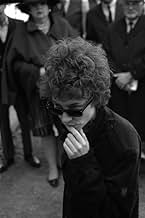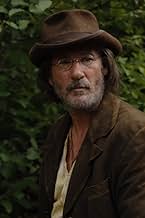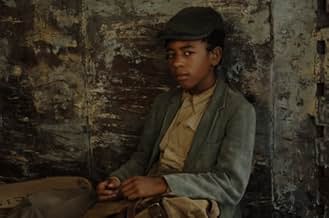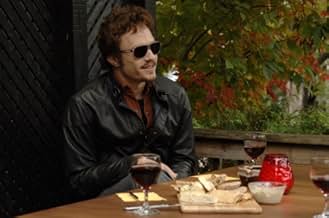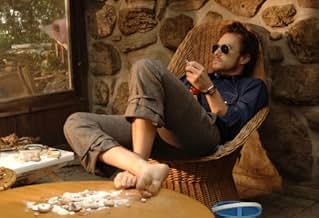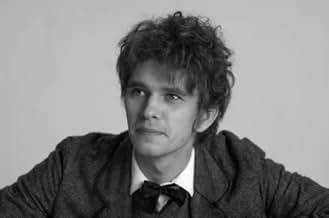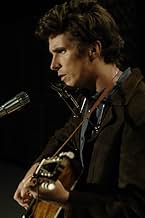I'm Not There
- 2007
- Tous publics
- 2h 15min
Des considérations sur la vie de Bob Dylan, à travers six personnages incarnant un aspect différent de la vie et de l'oeuvre du musicien.Des considérations sur la vie de Bob Dylan, à travers six personnages incarnant un aspect différent de la vie et de l'oeuvre du musicien.Des considérations sur la vie de Bob Dylan, à travers six personnages incarnant un aspect différent de la vie et de l'oeuvre du musicien.
- Réalisation
- Scénario
- Casting principal
- Nommé pour 1 Oscar
- 29 victoires et 49 nominations au total
- Hobo Moe
- (as Roc LaFortune)
- Circus Man
- (as Brian RC Wilmes)
Avis à la une
The much-publicised, overly re-hashed concept driving the film is this: Dylan is portrayed by six actors of different races, ages and genders, none of whom are named Dylan, but represent aspects of his personality and life story. Every art-house buff will squeal at this delightfully off-kilter concept (well, except that it's been done before) - but never used so cleverly I'll admit. But, the cleverness of the concept only remains clever if it is executed well. This is where most people have a problem with the film.
Most of what you may have read in reviews is correct. The film is challenging, borderline plot-less (unless you are generally acquainted with Dylan's life) and seems muddled (again, only if you don't have a general knowledge of his life). For anyone who can't grasp the basic, "each actor represents a stage etc." concept, this film will be lost on them completely... because it gets even more complicated! The film is so layered, with hidden in-jokes, and snippets of real quotes from songs and interviews with Dylan used as dialogue, and story lines within story lines. A great example is Heath Ledger's character: Ledger (an actor), plays an actor, playing Jack Rollins in a biopic, who is the representation of folk-singer-Dylan (a stage). An actor in a biopic playing an actor in a biopic about a singer representing Bob Dylan played by an actor in a biopic. The self-parody is just hilarious in this film.
To add to these 'layers', each actor's "stage" that they represent is filmed in a distinctive cinematic style, for example, the Cate Blanchett as Jude Quinn representing Bob Dylan sequence is shot in lush black and white. Haynes relishes this opportunity to show off, and he does. The film is stylistically stimulating, even if it does drag sometimes for ignoramuses like me who know literally nothing about Bob Dylan.
For those questioning the film's intentions as a biopic, I should think it was really obvious! The opening credits give a huge clue, as the main title comes up in stages: "I", "He", "I'm he", "I'm her", "Not her", "Not here", "I'm not there".
The film is like a dream: you come out of it with this vague (exact details in the film are scarce) and vivid impression of Dylan's personality, without learning anything. The title is certainly relevant - Haynes' actually conceals Dylan in this film! This biopic is conventional in the way it still presents a chronological life story if you arrange it all together and remember the actors represent one person, but it is different in the way it doesn't try to make a real person into a character for a film. This is really the only way to represent someone - by not.
This film is composed of stories and individual representations and metaphors that describe a person's life, their attitudes at points in time and aspects of their personality, but gives us nothing. Absolutely nothing.
So, if you're ready to put the level of effort and concentration required to appreciate and maybe like the film, go for it. But I was not prepared for this film and I wish I'd read a biography before I saw it. That said, not knowing anything did help in a way, as after we had several questions about events in the film and their basis in reality. After all, the trailer had told us that stories were exaggerated, fictionalised, imagined and true. It inspired me enough to look him up on Wikipedia (I know, such dedication!).
The performances are all generally good. Blanchett, Bale and Franklin impressed me the most. Blanchett only falls short because of her voice, but she has the accent correct, and she can't change her voice that much! She became more believable as the film progressed. Charlotte Gainsbourg is also quietly moving in her role as the neglected wife of Ledger's character.
My final opinion is that the film is well executed, but only once you've had time to ruminate on it, research Dylan and hear the director's thoughts on his own work. I read a great deal of reviews as well that helped me to understand (not that I didn't like the film initially; I liked it after I saw it anyway). Appreciation builds the more I learn about the film and the intricate connections between it and it's un-subject.
That said, should a film be this much hard work just to like? Not for some people, but for others, the effort is worth it. It does eventually pay off, but it's exhausting.
Often I say that essentially all films are about other films, rarely reaching life. This does that, reaching life, but by going through, punching through art by force. It presents a collage of images in such a way that we can see through the space in them to truth. Its an amazing feat. But in order for it to work, you have to have those patches sparkle for you.
So for instance you have to have internalized Fellini's one masterpiece, and be yearning for decades to escape the now close confines of the imagination set then. Of course when it was new, it was a wild ramble in the jungle, but now turn to tethers in the park. You really have to chafe at what passes for cinematic art, and dream of the next film, the one that will do for us what "8 1/2" did then.
You also have to have lived through the blasphemy of the Vitenam war and ideally have been on the "right side" throughout and still bear the pain of it. You have to seriously, even though the director is too young for this have had your life ruined by the revelation of a lying government, coupled with the spinning parade of false hopes from artists, many of whom we still admire. You have to have built your life taking into account mistrust.
But you also have to have had this particular dancer as a focus. This man who split into so many men, most of whom were designed to charm, all of whom weren't men at all but crystallized paths to salvation. You have to have invested in a few of these paths yourself enough so that it cost you more than it ever could Dylan.
If you have all of these traits then you already have the web on which this tarantula dances. And this will seep into you like some exotic solvent carrying subtle hallucinogens. And it will haunt you forever. Oh, you'll be able to slough it off and pretend that this is merely a clever puzzle of kinematic trivia. But this will hurt. It will hurt a lot, but only because of memories now defused.
It will make you soar as well, because it is so massively glorious. Many Dylans, well of course. Different ages, races, sexes. My, surely true.
Stories about films of one in another, about hiding from each other, about having sex with and spatting with each other. About disowning, and writing about each other. About one being another's blood, who is the hidden eyebrow of another in a Joycean web, but one that makes sense because it is made out of the stuff that made us.
What impresses me so much is that even before this was conceived the filmmaker had to know something like this fabric of selves existed. And he had to without having lived it himself develop deep intuitions about how this specific soul danced upon us in music and images. He had to understand how to borrow and bend those images with the music in ways that would make Julie Taymor blush: "Thin Man" used not for confused sexual tension but the conflating of superficial dylanology with artistic expiration. "Pat Garrett" as the context for a world rather than the escape from one. Over and over again the juxtapositions of life events, image and music (often performed by others in strange deviations) are all wrong but so right.
And then this artist had to see it all cinematically, to send it directly into our soul. I suppose this is a particularly broad leap because of the disconnected way this must have been made.
I celebrate this. You might wonder if it worked for someone, somewhere. It sure did for me.
Cate understands the whole enterprise, from the outside, all the way through every layer. What a soul!
Ted's Evaluation -- 4 of 3: Every cineliterate person should experience this.
'I'm Not There', regardless of having a talented big name cast, generally didn't do much for me. It is interesting sure, with a unique and quite bold concept, but it doesn't come off completely successfully. There are things to appreciate but it is understandable why some may dislike it, it's pretty divisive as a film.
Starting with 'I'm Not There's' good points, it is beautifully and atmospherically made and adeptly directed by Todd Haynes. Dylan's music is just great and beautifully incorporated and interpreted.
A big strength is the cast, a vast majority of them giving strong performances. Cate Blanchett, barely recognisable, is particularly excellent, with Christian Bale, Marcus Carl Franklin and Heath Ledger more than up to her level. There are some entertaining secondary performances from Charlotte Gainsbourg, David Cross and Julianne Moore. Dylan is remarkably multi-faceted, where we see him as a rebellious poet, a protest singer, a drug-addled rock star, a matinée idol with marriage woes, and a born-again Christian.
Not everything works. The concept does intrigue, but the time shifts do feel muddled and confusing. 'I'm Not There' is overlong with it going longer than necessary and the pacing rambles making the film drag.
While most of the cast are great, Richard Gere and his story are tacked on and uninteresting and Ben Whishaw is a little dull. The script could have been tighter and more cohesive.
Overall, not awful but underwhelming and easy to see why it's a divisive film. Bob Dylan deserved better than this. 5/10 Bethany Cox
You need to know that the characters all represent different aspects of Dylan, and that even though they are "Dylan" they have different names. Some of the Dylan aspects are personified as a young black boy using the name Woody Guthrie, a woman, and a middle-aged Billy the Kidd, for example. And the film jumps from character to character and then back again, frequently.
Chances are, if you are not an art film aficionado, you won't care for this one. On the other hand, if you do your Dylan homework, you may very well enjoy it even though it isn't typical mainstream movie fare.
While "Across the Universe" illustrated The Beatles' fantastic songs with simple, adorable characters in a psychedelic rhythm, but with little character development (not that I'm complaining: I absolutely love to see visual masters like Baz Luhrmann or Julie Taymor on fire, since their self-indulgence creates wonderful sensorial pieces), "I'm Not There" is much more complex: it's deeper than conventional biopics ("Ray", "Walk the Line"), and much smarter than exploitative flicks (the atrocious "Factory Girl"). Haynes crafted a unique film that's a feast for the eyes (thanks to cinematographer Ed Lachman, "The Virgin Suicides", who also co-directed the disgusting "Ken Park" with Larry Clark), ears (Dylan's music is always a pie in the sky) and mind (it'll make you admire the man even more, and it doesn't even need to be an ass-kissing biopic to succeed on that).
The cast is heterogeneous and solid, but I think critics are overrating Cate Blanchett for the sheer fact that she's playing a man (which makes things more challenging for her, indeed), when she's not really better than most of the cast; a good performance for sure, but I was much more impressed by Christian Bale and the young revelation Marcus Carl Franklin. Julianne Moore, Charlotte Gainsbourg and Michelle Williams play some important women from Dylan's life, and the always underrated Bruce Greenwood has a small but interesting part. All in all, this isn't a film that will enjoy big commercial success, and it's probably too artsy (although, not in a bad way) to get the Academy's top prize (even though Blanchett's performance and, maybe, Haynes's magnificent directing/writing, will probably be remembered), but it's a real gem for those who want to see something really exciting and original. As for myself, I'm thankful to Haynes and his audacious, faithful producer Christine Vachon (this woman rocks, and in a perfect world, she'd have all the money that a certain Jerry Bruckheimer possesses), who always dare to blow us away - something rare, these days. Fascinating. 10/10.
Le saviez-vous
- AnecdotesTodd Haynes needed to get approval from Bob Dylan to use his music, since (unlike in his Velvet Goldmine (1998) where David Bowie did not give his permission for his music) he felt the film would not work without it. At the encouragement of Dylan's manager, Haynes wrote a one-page summary of his concept and the characters, which Dylan approved. It took another 6 years to get the film made due to funding difficulties.
- GaffesWhen Woody's character is first seen he is running towards a train going North but when he is sitting on the train, it is noticeably going South.
- Citations
Billy the Kid: People are always talking about freedom. Freedom to live a certain way, without being kicked around. Course the more you live a certain way, the less it feel like freedom. Me, uhm, I can change during the course of a day. I wake and I'm one person, when I go to sleep I know for certain I'm somebody else. I don't know who I am most of the time.
- Crédits fousThe way the title appears on the screen at the opening would read: I he I'm her not her not here. I'm not there" (period included).
- Bandes originalesGoin' to Acapulco
Performed by Jim James and Calexico
Written by Bob Dylan
Published by Dwarf Music (SESAC)
Produced by Joey Burns
Jim James appears courtesy of ATO Records
Calexico appears courtesy of Quarterstick Records
Meilleurs choix
Détails
- Date de sortie
- Pays d’origine
- Sites officiels
- Langue
- Aussi connu sous le nom de
- Mi historia sin mi
- Lieux de tournage
- Sociétés de production
- Voir plus de crédits d'entreprise sur IMDbPro
Box-office
- Budget
- 20 000 000 $US (estimé)
- Montant brut aux États-Unis et au Canada
- 4 017 609 $US
- Week-end de sortie aux États-Unis et au Canada
- 730 819 $US
- 25 nov. 2007
- Montant brut mondial
- 11 792 542 $US
- Durée2 heures 15 minutes
- Couleur
- Mixage
- Rapport de forme
- 2.35 : 1
Contribuer à cette page





